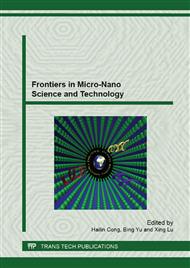p.98
p.105
p.110
p.115
p.123
p.129
p.134
p.141
p.152
Microwave-Assisted Preparation of Nitrogen Doped Nano-TiO2 and the Study on the Properties
Abstract:
The nitrogen doped nanoTiO2 was prepared by the microwave-assisted method. The properties were characterized by the X-ray diffraction (XRD) and field emission scanning electron microscopy (FESEM). The effects of the calcination temperature and the doping amount of nitrogen on the nitrogen doped nanoTiO2 crystal phase and its photocatalytic properties were studied. The result indicated that with the increase of the calcination temperature, the proportion of rutile in the mixed crystal phases increased gradually. When the calcination temperature was 650°C, the pure rutile phase appeared. When the TiO2 was calcinated at 400 °C, the particle size was the minimum (17nm). This mixed crystal was conducive to the good photocatalytic properties of nanoTiO2. The degradation rate of methyl orange was 50.86%. At the calcination temperature of 450 °C, the proportion of rutile in the mixed crystal phase increased first and then decreased, until finally it increased again with the increase of the doping amount of nitrogen. When the ratio of nitrogen to titanium was 1:0.5, the catalytic effect was the best. The photocatalytic degradation efficiency was 71.63%, and the particle size was also approximately the minimum (15nm).
Info:
Periodical:
Pages:
123-128
Citation:
Online since:
April 2014
Authors:
Price:
Сopyright:
© 2014 Trans Tech Publications Ltd. All Rights Reserved
Share:
Citation:


